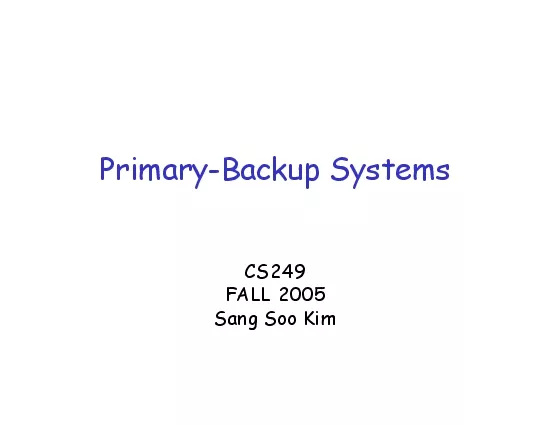

CS249FALL 2005Sang SooKimActive Replication vs PrimaryBackupIn activereplication state machine approach from Ch7oClient sends request to all serversoAll servers execute all requestsFailure of any se ID: 860164
Download Pdf The PPT/PDF document "PrimaryBackup Systems" is the property of its rightful owner. Permission is granted to download and print the materials on this web site for personal, non-commercial use only, and to display it on your personal computer provided you do not modify the materials and that you retain all copyright notices contained in the materials. By downloading content from our website, you accept the terms of this agreement.
1 Primary-Backup Systems CS249 FALL 2005 S
Primary-Backup Systems CS249 FALL 2005 Sang SooKim Active Replication vs. Primary-Backup In active-replication (state machine approach
2 from Ch.7) oClient sends request to all
from Ch.7) oClient sends request to all servers oAll servers execute all requests Failure of any server is masked In primary-backup sys
3 tems oClient sends request only to one d
tems oClient sends request only to one designated primary server executes the request oIf the primary fails, one of the backup servers
4 becomes the primary Formal Specification
becomes the primary Formal Specification A Primary-backup system is required to satisfy the following properties: o o Pb1 Pb1 atany tim
5 e.” o o Pb2 Pb2 : “Client send
e.” o o Pb2 Pb2 : “Client sends request to only to one server it thinks is the primary” o o Pb3 Pb3 : “Non-primarie
6 s do not process client requests.”
s do not process client requests.” Formal Specification(Con’t) Every request requires a response to be sent A server outage o
7 ccurs at time tif a client sends a reque
ccurs at time tif a client sends a request at tbut receives no response. )-bofoserver Pb4Pb4: “There exists fixed values kand such
8 that the service behaves like a single
that the service behaves like a single ( k , )-bofoserver.” (1, 2t1)-bofo t1 t2 A Simple Primary-Backup Protocol ClientPrimary Ba
9 ckup Primarysends seconds.If backuprecei
ckup Primarysends seconds.If backupreceives no such message for )-bofo The ordering of messages 2 & 3 matters! o(see next slide) 1.requ
10 est2.State-update3.response Response bef
est2.State-update3.response Response before state-update? Suppose response is sent before state-update message. Then if the primary cra
11 shes before sending state-update oWhen
shes before sending state-update oWhen the backup server becomes the primary later, the client will face inconsistency at the server.
12 ClientPrimary Backup 1.request3.State-up
ClientPrimary Backup 1.request3.State-update2.response 4.i’m primary Cost Metrics 1.Degree of replication: How many servers are ne
13 eded to provide a f-fault-tolerant servi
eded to provide a f-fault-tolerant service? 2.Blocking time: What is the worst-case response time for a request? 3.Failover time: What
14 is the worst-case interval during which
is the worst-case interval during which requests can be lost because there is no primary? Failure Models Crash-failure: A server may ha
15 lt by crashing. It does not perform any
lt by crashing. It does not perform any further operations. Crash + Link Failures: A server may crash or a link may lose messages (but
16 no delay, duplicate, or alter messages)
no delay, duplicate, or alter messages) some messages over non-faul Receive Omission: A server fails by receiving only a subset of mess
17 ages sent to it or by halting by crash.
ages sent to it or by halting by crash. General Omission Failures: A server may exhibit send-omission or receive-omission failures. Low
18 er Bounds: (1)Replication Failure Model
er Bounds: (1)Replication Failure Model Degree of Replication Crashn� f Crash + Link Receive-Omissionn� 3f / 2 Send-Omi
19 ssionn� f General-Omissionn�
ssionn� f General-Omissionn� 2f nn= # of serversff= # of failures that can be tolerated Replication (con’t) �
20 0;Crash and Send-omission: n f oTo tole
0;Crash and Send-omission: n f oTo tolerate f failures, there should be at least (f+1) servers in the system Replication (con’t)
21 �Crash + Link: n f + 1 oProof by
�Crash + Link: n f + 1 oProof by Contradiction f... 1 AB f links fCrashed!!!Primary Primary in this group 1Crashed! f links fa
22 il References NavinBudhiraja, Keith Marz
il References NavinBudhiraja, Keith Marzullo, Fred Schneider, Sam Touegin “Distributed Systems”(Addison-Wesley) http://www.cs
23 .unc.edu/~anderson/teach/comp247/ cache/
.unc.edu/~anderson/teach/comp247/ cache/14-passive.ppt www-users.itlabs.umn.edu/classes/Spring-2002/csci8102/ClassNotes/Lecture7/Lectur